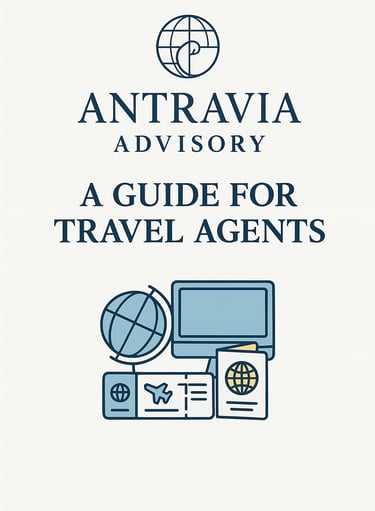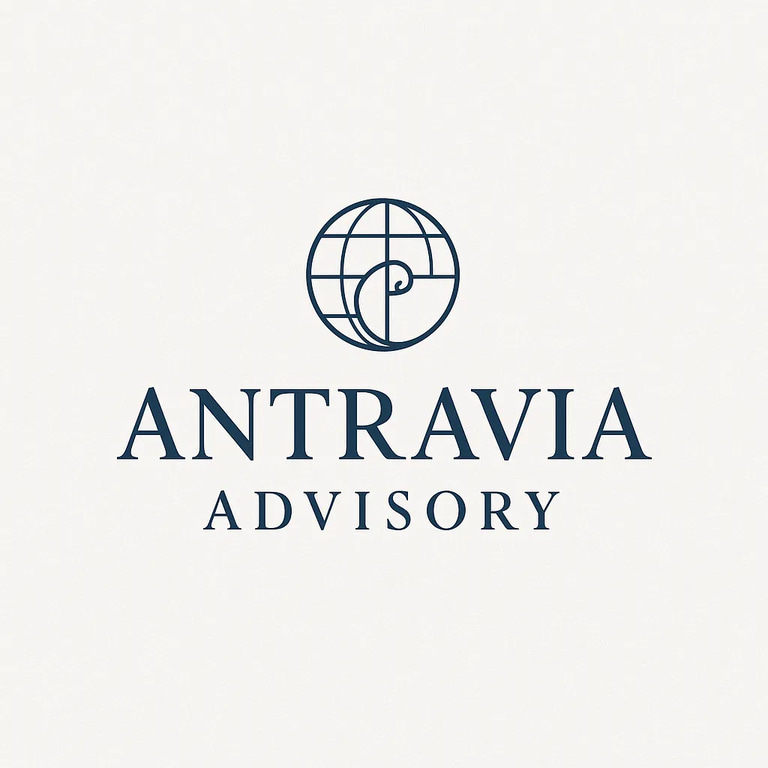
Travel Agent Finance Guide 2025: 7.2 Growing Beyond Solo: Payroll, Compliance, and Independent Contractors
Part 7.2 of the Antravia Travel Agent Finance Guide - Learn when to move from sole proprietor to employer, how to manage payroll vs. 1099 setups, and what 2025 DOL and IRS rules mean for U.S. travel agencies expanding with staff or contractors.
ANTRAVIA TRAVEL AGENT GUIDE
1/26/20255 min read


Part 7 Technology, Scaling, and Exit Planning
As agencies mature, financial priorities shift from survival to structure.
Part 7 of the Travel Agent Finance Guide focuses on how to scale sustainably by using technology, process discipline, and long-term financial planning to build transferable business value.
This section connects the operational work of Parts 4–6 to the strategic horizon: how to run your agency as an asset, not just an income stream.
7.1 Building a Scalable Tech Stack: Accounting, Automation, and CRM for Travel Agencies
How to choose accounting and reporting systems that scale with growth.
Integrating CRM, booking, and financial data for real-time visibility.
Automating reconciliations, payables, and commission tracking.
Building dashboards for key metrics (cash, margin, client type, region).
7.2 Growing Beyond Solo: Payroll, Compliance, and Independent Contractors
When to move from sole proprietor to employer — payroll vs. 1099 setups.
Financial implications of using independent contractors (ICs) vs. employees.
Compliance risks under U.S. Department of Labor and IRS definitions.
How to manage multi-state reporting and benefits as you expand.
7.3 Retirement and Wealth Planning for Travel Advisors
How to structure personal and business finances for long-term security.
Setting up SEP-IRAs, Solo 401(k)s, and profit-sharing plans.
Planning cash-flow continuity for semi-retirement or succession.
Using retained earnings and dividends tax-efficiently.
7.4 Valuation and Exit Strategies
What drives business value in a travel agency.
How to make profits predictable and transferable.
Preparing financial statements and KPIs for buyers or investors.
Structuring sales or mergers to minimize tax and protect legacy.


Part 7.2 Growing Beyond Solo: Payroll, Compliance, and Independent Contractors
Structuring Your Team for Scale and Financial Control
Expanding from a one-person agency into a staffed business is both a growth milestone and a regulatory turning point. The decision to hire employees or work with independent contractors (ICs) affects cash flow, tax reporting, and liability exposure. For U.S. travel agencies, choosing the right model requires balancing flexibility with compliance.
1 When to Move from Sole Proprietor to Employer
Many U.S. travel advisors start as single-member LLCs or sole proprietors, but once revenue becomes predictable or client volume exceeds what one person can manage, payroll becomes the next step.
You’re ready to employ when:
You delegate client contact, sales, or accounting tasks that require consistent oversight.
You need to control branding, service standards, or commission distribution.
You exceed IRS “independent contractor” thresholds for supervision or exclusivity.
Switching to payroll allows you to formalize employment, pay regular salaries or draws, and comply automatically with state and federal tax-withholding rules.
Typical triggers:
$250,000 + annual revenue or 3–5 regular team members.
The agency operates under a single brand and controls how advisors perform their work.
2 Payroll vs. 1099 Independent Contractor Setups
Payroll employees receive W-2 wages. You withhold and remit federal income tax, Social Security, and Medicare contributions and may provide benefits (health, 401(k), PTO).
Financial impact: adds roughly 10–12 percent in employer taxes and benefits to total labor cost but reduces compliance risk.
Independent contractors (ICs) are paid via Form 1099-NEC. You don’t withhold payroll taxes or provide benefits, but the IRS and Department of Labor scrutinize these arrangements.
Advantages:
Lower overhead and flexible scaling.
ICs absorb self-employment taxes (15.3 %).
Risks:
Misclassification penalties can exceed $5,000 per worker plus back taxes.
If ICs use your tools, follow your hours, or appear as staff, the IRS may reclassify them as employees.
A 2025 DOL rule, effective March 11, 2024, reinstated the “economic reality” test, evaluating six factors such as control, opportunity for profit, and permanence of the relationship. Agencies directing day-to-day work should assume employment status.
3 Compliance Risks and Labor Definitions
The IRS 20-Factor Test and the DOL six-factor framework remain the governing standards.
Key red flags for misclassification include:
Mandating fixed work hours or office attendance.
Providing all client leads and systems without independent decision-making.
Restricting an IC from working with other agencies.
Violations can trigger joint IRS/DOL audits. To protect your agency:
Keep signed contracts clarifying IC autonomy.
Avoid giving ICs company email addresses or titles implying employment.
Issue annual 1099s through IRS e-File or QuickBooks Payroll.
4 Multi-State Reporting and Payroll Expansion
Remote hiring widens your reach but complicates compliance.
If staff live in multiple states, you must register for state withholding and unemployment insurance in each jurisdiction. Also consider potential Nexus implications.
Cloud payroll providers like Gusto, ADP Run, and QuickBooks Payroll Elite automate filings and produce multi-state W-2s.
For hybrid models (some employees, some ICs):
Maintain separate contracts and pay schedules.
Store payroll and IC data in distinct ledgers for audit clarity.
Reconcile tax deposits monthly to prevent interest charges.
Example:
A Florida-registered agency with remote staff in Texas, New York, and Colorado needs active payroll accounts in all three states. Failure to register can result in state tax liens even if federal filings are current.
5 Benefits, Insurance, and Retirement Planning
Once payroll begins, benefits signal stability and help retention.
Health coverage: small-group plans available once you have two employees.
Retirement: SEP-IRA or Solo 401(k) transitions to a traditional 401(k) when you add staff.
Liability coverage: update your Errors & Omissions and Workers’ Comp policies to include employees; many states require it.
Providing structured benefits also increases sale value, since a documented benefits framework is viewed favorably by acquirers.
6 Financial Management and Automation Tips
Use Gusto, QuickBooks Payroll, or ADP Run for automated withholdings and W-2 generation.
Integrate payroll with your accounting system to capture employer taxes automatically.
Record IC payments through QuickBooks Contractor Center or Gusto Contractor Hub for 1099 automation.
Reconcile payroll liability accounts monthly.
7 Further Antravia Research
For practical guidance, see related Antravia blogs:


References for Part 7.2 Payroll, Compliance, and Independent Contractors
U.S. Department of Labor (2024) – Employee or Independent Contractor Classification under the Fair Labor Standards Act
https://www.dol.gov/agencies/whd/flsa/misclassificationInternal Revenue Service – Understanding Employee vs. Contractor Status
https://www.irs.gov/businesses/small-businesses-self-employed/independent-contractor-definedU.S. Small Business Administration (SBA) – Hiring and Payroll for Small Businesses
https://www.sba.gov/business-guide/manage-your-business/hire-manage-employeesGusto – 2025 Multi-State Payroll Compliance Guide
https://gusto.com/
Acknowledgements
Antravia would like to thank our consulting clients and industry partners who generously shared their time, insights, and real-world case studies. All client examples have been anonymized and edited for clarity, but they are based on true advisory engagements and reflect real decisions, challenges, and financial outcomes from across the travel industry.


Antravia Advisory
Where Travel Meets Smart Finance
Email:
Contact us:
Antravia LLC
© 2025. All rights reserved. | Disclaimer | Privacy Policy | Terms of Use | Accessibility Statement
Antravia.com - Global site of the Antravia Group.
Antravia.com | Antravia.co.uk | Antravia.ae |
Finance.travel | Tax.travel | Consultancy.travel | Vat.travel | Vat.claims |
USSales.tax | EuroVAT.tax | UKVAT.tax |
contact@antravia.com
Antravia LLC
4539 N 22nd St., Ste. N
Phoenix
Arizona
85016
